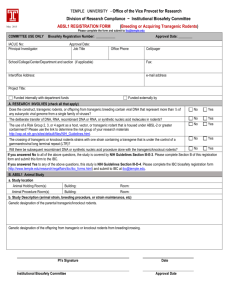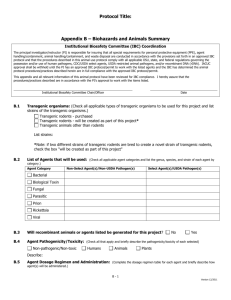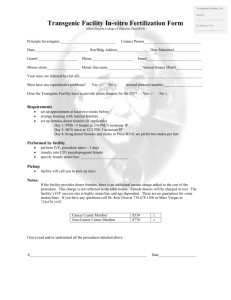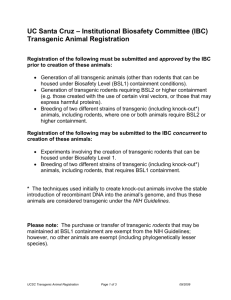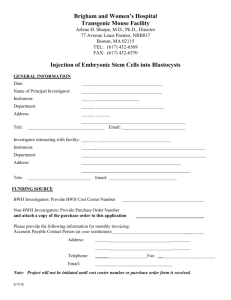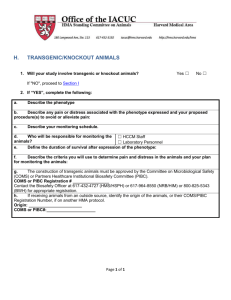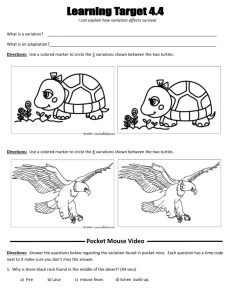Rodents in Neuroscience Research
advertisement
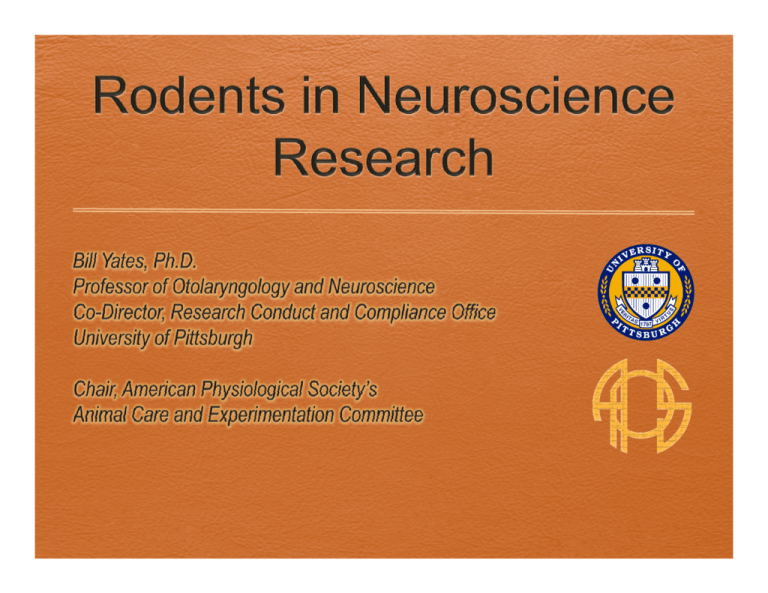
Use of Most Animal Species Has Declined Over the Decades Data for the United States. Data for rats, mice, birds, and cold-blooded vertebrates are not tracked. Source: United States Department of Agriculture (USDA) Annual Reports Use of Most Animal Species Has Declined Over the Decades Data for the United States. Data for rats, mice, birds, and cold-blooded vertebrates are not tracked. Source: United States Department of Agriculture (USDA) Annual Reports and National Institutes of Health (NIH) website. Use of Most Animal Species Has Declined Over the Decades; the Exception is Mice Data for the United Kingdom. Source: United Kingdom Home Office Website. The Fall of the Feline in Neurophysiological Studies ¹ Although rodents have traditionally been the major species utilized for many types of neuroscience research (e.g., behavioral studies), felines were a major species used for neurophysiological studies prior to the mid-1980s. ¹ Examples are studies of visual processing by the brain (Nobel prize for Hubel and Wiesel in 1981) and processing of somatosensory inputs by the spinal cord (Nobel prize for Eccles in 1963). ¹ Cats were popular research animals for classical neurophysiological studies because they: ¾ ¾ ¾ Could withstand the extensive surgeries required Were large enough to accommodate bulky instrumentation Were inexpensive models (obtained from pounds or animal shelters; limited paperwork requirements) The Fall of the Feline in Neurophysiological Studies ¹ In the mid-1980s, new regulations substantially increased the cost of the feline model. ¹ Miniaturization of instrumentation allowed rodents to serve as replacements for felines in some studies. ¹ Public opinion became negatively biased against the use of companion animals in research. ¹ Chronic recording techniques allowed a single animal to be studied over a prolonged time, such that fewer animals were needed for a study. The use of nonhuman primates became economically feasible. ¹ Nonhuman primates can be trained for more elaborate tasks than cats, allowing for sophisticated studies of neural function. The Transgenic Mouse Revolution ¹ The first knockout mouse was created by Mario R. Capecchi, Martin Evans and Oliver Smithies in 1989, for which they were awarded the Nobel Prize for Medicine in 2007. ¹ The mouse is the only mammalian species that has been readily amenable to gene knockout (until recently). ¹ It is also now possible to insert human genes into a mouse, and to overexpress particular genes. ¹ Use of transgenic animals has allowed neuroscientists to decipher the function of particular genes, and to create disease models. Source: Website of the Nobel Prize in Physiology or Medicine 2007. The Transgenic Mouse Revolution ¹ Use of knockout animals has provided a number of critical advances in neuroscience research: ¾ ¾ ¹ Knockout mouse models of Alzheimer’s disease are shedding light on treatment options. Knockout mouse models have been critical in understanding the neural basis of learning and memory. Transgenic mice likely account for ~ ⅔ or more of the mice, and over half of the mammals, used in biomedical research. # Procedures on Mice in UK, 2009 Normal Animal Transgenic Animal Source: United Kingdom Home Office Website Limitations of the Transgenic Mouse ¹ Some genetic diseases have different characteristics in mice and humans: ¾ ¾ Transgenic models of Parkinson’s disease often don’t exhibit the same neural degeneration that humans do. Although the mouse Huntington gene is 81% identical to the human Huntington gene, knockout of the gene in mice leads to death during embryogenesis (in contrast, the human disease emerges in adulthood). ¹ Diseases that involve multiple genes have been difficult to create in transgenic models. ¹ Compensation for the effects of gene manipulation can occur, which can lead to false conclusions about the role of particular genes. Are Rodents Ideal Research Models? PROs CONs ¹ Rodents typically live < 2 years, which facilitates aging studies ¹ Rapid aging can confound repeated measures over time in the same subject ¹ The small size of rodents allows many animals to be maintained in a limited space ¹ The small size of rodents provides constraints on the manipulations and measurements that are possible ¹ Rodents serve as excellent models of some human diseases ¹ Some human disease conditions cannot be mimicked in rodents Research results need to be reproduced in multiple species to assure they are shared between all mammals. Some findings in rodents might be unique for rodents. Some Studies are Better Done in Carnivores ¹ Rodents and rabbits lack the ability to vomit, such that carnivores remain the best model animals to study emesis and conditions that elicit emesis (e.g., motion sickness). ¹ Rodents lack respiratory responses such as coughing and sneezing; carnivores remain the best model for studying cough suppressing drugs. ¹ Ferrets are susceptible to most strains of influenza that infect humans, and are the best animal models for influenza treatments. ¹ Feline immunodeficiency syndrome remains one of the best analogs of human acquired immunodeficiency syndrome (AIDS). Universal Knockouts ¹ Zinc-Finger Nuclease technology has allowed the creation of knockout rats. ¹ Theoretically, the technique should work for inactivating genes in any species, including humans. ¹ The balance of species used in biomedical research may change as new transgenic animals become available. New Regulatory Challenges ¹ New regulatory challenges are on the horizon in the United States and Europe. ¹ Impacts of the new regulations are increased recordkeeping requirements, and increased cost of conducting biomedical research. ¹ It is unclear whether the increased costs and burdens will be paralleled in improved animal welfare. Conflicting Regulatory Challenges ¹ In addition to animal welfare regulations (two laws in the United States, and two sets of regulations), many additional rules and standards are applicable to research using animals. ¹ For example, transgenic animals fall under the regulation of NIH’s Office of Biotechnology Activities (OBA). ¹ The US Food and Drug Administration (FDA) has also claimed oversight authority for transgenic animals, but has not yet exerted oversight action (except for genetically engineered food species). 9 The promulgation of overlapping and confusing regulations increases the cost of biomedical research, thereby limiting scientific progress. 9 There is little consideration for balancing animal welfare and regulatory burden. 9 It is rare to consider the investigator’s perspective during rulemaking. 9 Streamlined regulations are needed that protect animals while facilitating progress.

